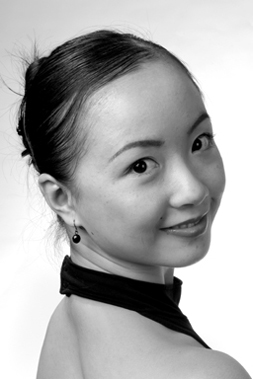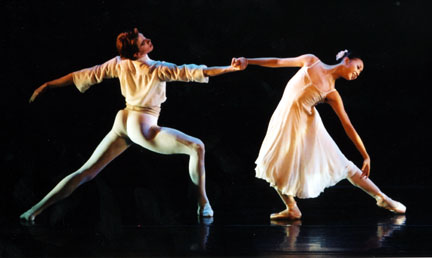McKerrow's Powerful Hagar, and an Extraordinary Debut
Master
Works Program
Diversion of Angels/Symphonic Variations/Pillar of Fire/Raymonda
American Ballet Theatre
City Center
New York, NY
November 5, 2003
by Mary
Cargill
copyright © 2003 by Mary Cargill
The center piece of the ABT season is the revival of Antony Tudor’s Pillar of Fire, staged by Donald Mahler. Three Hagars shared the six performances, and Amanda McKerrow gave her first New York performance (and next to last one, too, if rumors of her retirement are true; she repeats the role Friday night) on November 5. McKerrow had worked extensively with Tudor on the part of the Younger Sister, so her performance was greatly anticipated by the eager audience. It was, I would suspect, one of the last chances to see a dancer who had actually worked with one of the great 20th century choreographers.
Pillar of Fire’s approach to guilt and shame is a bit out of sync with our modern sensibilities, but the fear of isolation and of loneliness that underlies Hagar’s character is timeless, and I thought McKerrow used her outward frailty and inner strength powerfully. The opening, when she is sitting on the steps by herself off in the corner, almost rigid with the pain of isolation, grabbed the audience, in part because it was not overtly dramatic. There was no eyebrow acting, just repressed feeling. She danced with extraordinary control, so that the occasional wild gestures, which can look overwrought, seemed almost shocking, as if her feelings were forcing themselves out, despite her efforts to control them. When the Man from the House Opposite (Angel Corella, who performed with a sullen, smoldering, heedless arrogance) sauntered past her, McKerrow’s sudden, spasmodic clutch was like an unwilling scream.
But her Hagar was not a one-note neurotic. She was able to control the tension in her body to indicate Hagar’s daydreams, relaxing slightly and moving softly among the Lovers-in-Innocence, than then tightening up as reality intruded. It was the kind of performance that has reviewers looking for synonyms to “searing” and “unforgettable.”
Sir Frederick Ashton’s Symphonic Variations tends to send reviewers to their thesauruses as well, looking for something besides “limpid” to describe that magnificent work. It is very difficult to dance, since it needs an atmosphere of classical, yet warm, serenity, combined with extraordinarily difficult, but not flashy, dancing. The technique has to be there, but the dancers cannot hide behind it. Cynthia Harvey (who was in ABT’s first version, coached by the late Michael Somes, the original leading man) has said that Somes stressed that the six dancers should give the appearance of being friends, and this generous and understated warmth on top of the fierce technical challenges did not always come through this version (coached by Wendy Ellis, Somes’ widow.) The opening section occasionally seemed severe rather than serene, but clearly the dancers were trying to honor the intricacies of the choreography, and the dancing had shape and flow, unmarred by any of the current flashy distortions.
 Wednesday
evening saw the debut of a new, and by and large, very successful cast.
Marcelo Gomes, in the Somes role, was fluid and powerful, with a true
sense of classical otherworldliness. Stella Abrera, in the Fonteyn part,
was a bit too brittle, though she should improve with experience. Some
viewers felt that the earlier cast needed more experienced dancers for
the two side girls, and that cast did looked at times like they were just
trying to catch up with the fast and delicate footwork, bringing their
arms along behind them. However, experience isn’t the only key,
as the inspired casting of Zhong-Jing Fang, an apprentice, showed. She
is a perfectly proportioned dancer, with a noble yet modest carriage;
just the set of her shoulders and tilt of her chin said volumes about
the beauty of true classical dancing. Her instinctive grace and response
to the music was so moving. Even when she was standing still, you could
see the music through her eyes. As the one who first offers her hand at
the beginning of the simple yet miraculous chain of dancers, I did believe
that she was giving her hand to a friend.
Wednesday
evening saw the debut of a new, and by and large, very successful cast.
Marcelo Gomes, in the Somes role, was fluid and powerful, with a true
sense of classical otherworldliness. Stella Abrera, in the Fonteyn part,
was a bit too brittle, though she should improve with experience. Some
viewers felt that the earlier cast needed more experienced dancers for
the two side girls, and that cast did looked at times like they were just
trying to catch up with the fast and delicate footwork, bringing their
arms along behind them. However, experience isn’t the only key,
as the inspired casting of Zhong-Jing Fang, an apprentice, showed. She
is a perfectly proportioned dancer, with a noble yet modest carriage;
just the set of her shoulders and tilt of her chin said volumes about
the beauty of true classical dancing. Her instinctive grace and response
to the music was so moving. Even when she was standing still, you could
see the music through her eyes. As the one who first offers her hand at
the beginning of the simple yet miraculous chain of dancers, I did believe
that she was giving her hand to a friend.
Diversion of Angels, Martha Graham’s meditation on various types of love, opened the program. Michele Wiles and Carlos Molina were the couple in white, the mature lovers whose contentment is briefly threatened by Ashley Tuttle’s erotic love. ABT has danced this for several seasons, and it is a wonderful work, even if they over-balleticize it a bit. The amazing balances tend to look like amazing balances, not like characters reacting to each other. There were exceptions, of course, and Carlos Molina got the feeling of being pulled between serenity and the enticing girl in red. Jesus Pastor, too, a recent recruit via the amazing Ullate School, had a bounding charm.
The excerpts from the final act of Raymonda, staged by Anna-Marie Holmes, continue to look a bit like a dress rehearsal for the proposed full-length production this summer. The set, which should represent a sumptuous palace, has a tiny balustrade and a few excuse-me chandeliers. The costumes, borrowed from another production, are not flattering, and the men, inexplicably, have no hats. This gives them a fly-away look, and the famous male pas de quatre looked a bit like it was danced by boys from the steppes of Montana.
There is a new male duet, danced impeccably by Herman Cornejo and Carlos Lopez, which is more interesting and musically varied than the steps on steroids interpolations in ABT’s Le Corsaire, but Petipa’s ballets are really about women. Raymonda has one of the most beautiful and womanly solos ever made, with its Hungarian folk dance inflections, set to dazzling Glazunov music. For some reason, the ABT dancers just mime Raymonda’s electric claps, which eliminates some of the solo’s flavor. Balanchine, in his variation of Petipa’s choreography, which he saw as a child, kept the claps, and so did Nureyev for his Royal Ballet version, so the mimsy little hand wiping movements must be comparatively recent. But Irina Dvorovenko, with a very elegant Maxim Beloserkovsky, was lively, if not quite magisterial, and if not on the level of the other works on the program, this Raymonda was loads of fun.
But not as much fun as thinking about the wonderful performances Amanda McKerrow has given us in the past, or as hoping for further chances to see Zhong-Jing Fang.
Photo: ABT Apprentice Zhong-Jing Fang. PHOTO: Marty Sohl

We didn't
have a photo of this cast of Symphonic Variations, but here's
Zhong-Jing Fang, with Bo Busby, in Continuo. Photo: : Rosalie
O'Connor
Originally
published:
www.danceviewtimes.com
Volume 1, Number 6
November 5, 2003
Copyright ©2003 by Mary Cargill
|
|